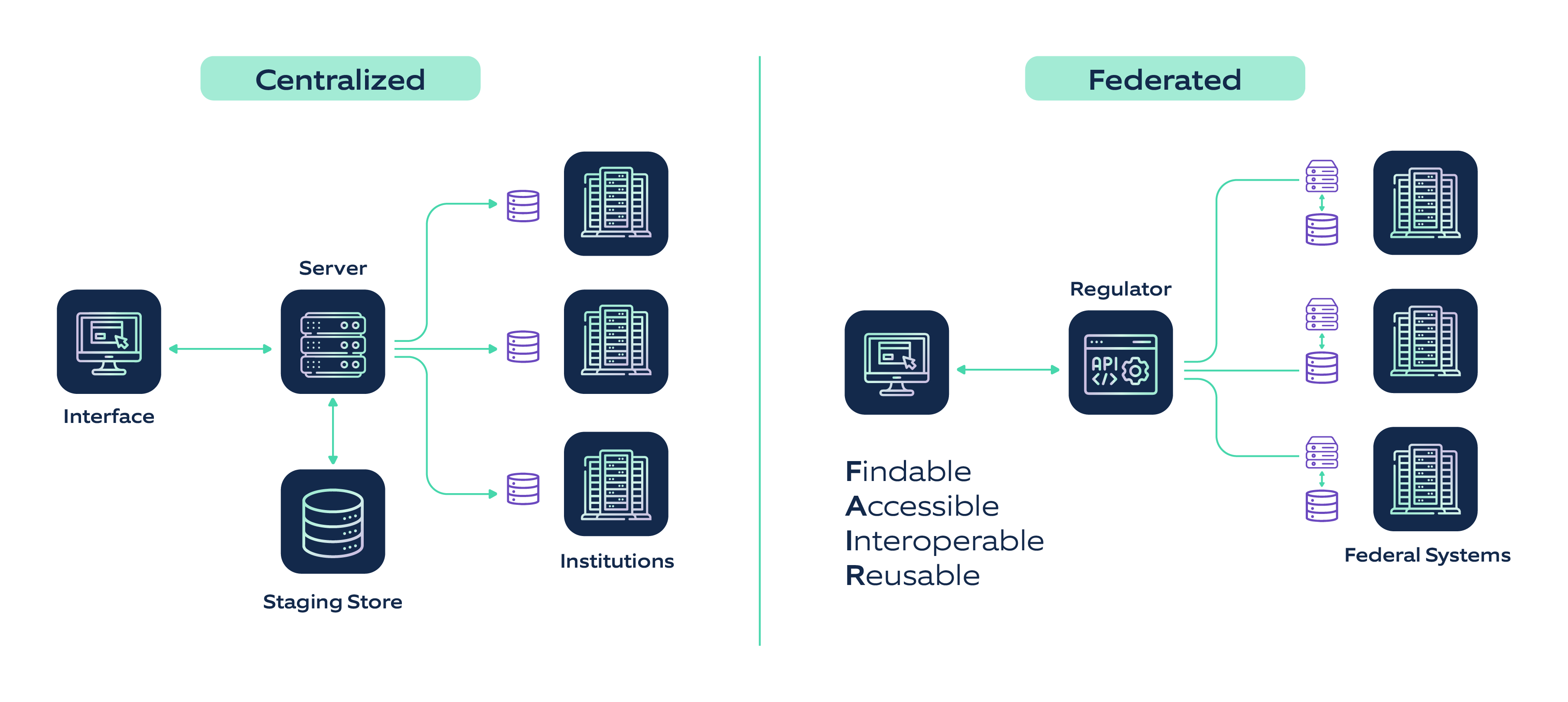The vision of a "Fluidic Enterprise", a company that can continuously adapt to change, is becoming the guiding principle for future-oriented corporate transformation. The key lies in targeted access to distributed data through APIs, whereby a federated approach is essential, especially for complex companies. This article describes this model, explains core elements and offers practical insights into how the transformation process - flanked by change management - can be successfully designed.
In the increasingly complex and dynamic VUCA world, companies and their employees are increasingly challenged to operate in network-like structures. These often collide with traditional, rigid communication and decision-making processes, and the culture shaped by the traditional hierarchy. Against this background, we see the "Fluidic Enterprise" as a new model for forward-looking transformation.
Fluidic Enterprise model – motivation and advantages
At the heart of the Fluidic Enterprise is the human being (see figure 1).
Technology is meant to support employees in completing their daily tasks efficiently and effectively. However, people should never have to bend themselves for technology. The main characteristics of a Fluidic Enterprise are responsiveness, efficiency, trust, creativity, and sustainability. This model offers a flexible framework that allows companies to tailor their transformation to their specific needs regarding the target state and the path to get there.
 Figure 1: Characteristics of a Fluidic Enterprise
Figure 1: Characteristics of a Fluidic Enterprise
Federated API management as a technical foundation
To act as flexibly as possible, it is advisable for the Fluidic Enterprise to work in network-like structures. In this context, data can be understood as a core resource in value creation. To make this core resource available across the board and thus connect distributed systems and applications, companies use Application Programming Interfaces (APIs). These APIs standardize data exchange, leading to higher cost efficiency, flexibility, and security. API management solutions provide functions along the API lifecycle, including API development standardization, security enforcement, establishment of API governance, cataloging, version control, and publication of APIs. Additionally, API management solutions offer KPI-based monitoring, analysis of usage and access patterns, and API packaging and monetization.
Typically, we see the central IT department of a company initiating and driving the topic of API management. To unlock the various potentials, especially concerning new products, additional communication and sales channels, and platform-based business models, we believe that API management should be conceived strategically, anchored across the company, and designed interdisciplinarily. This would enable comprehensive collaboration – both between IT and business as well as between central and decentralized teams. This is particularly challenging for larger and often more complex companies, frequently leading to latent or even openly carried conflicts.
A promising approach to avoiding or overcoming these conflicts is "Federated Deployment." Here, the central IT is responsible for providing a common API infrastructure and governance, while decentralized business and IT teams are responsible for the operational development and provision of APIs. Federated API management enables improved collaboration between organizations, promotes innovation and efficiency in the development and use of APIs across organizational boundaries, and helps maintain standards.
The architecture and practice of Federated API Management span several often decentralized organizations or domains. Compared to the centralized approach, where a single instance controls all APIs, federated API management allows collaboration and API exchange across many often independent units.
Integration into federated API management includes seamless connection and interoperability of APIs across different domains, networks, and platforms. It aims to bridge the gaps between different systems and enable centralized management and control of API management. The key features of federated API management (FAPI, see figure 2) include:
- Governance and policy enforcement: FAPI enforces uniform governance policies for all integrated APIs, ensuring compliance with security standards, data protection regulations, and access control rules. It provides centralized authorization and authentication mechanisms for managing user access.
- Decentralization and security: FAPI is based on a decentralized architecture where APIs are managed and controlled within their respective domains while providing a central view and control mechanism. This approach ensures local autonomy and security while simultaneously offering global visibility and control.
- Heterogeneity and interoperability: FAPI facilitates the integration of APIs from various sources, such as legacy systems, cloud-based services, and third-party providers. It promotes interoperability by adhering to open standards and protocols, allowing APIs to communicate and exchange data regardless of underlying technologies.
- Developer experience and self-service: FAPI enhances the developer experience by providing standardized API catalogs, intuitive documentation, and self-service tools for API discovery, onboarding, and usage. It encourages developers to build on existing APIs and foster innovation.
- Composition and mashup capabilities: FAPI enables the composition of multiple APIs into new, more complex services, allowing developers to create innovative solutions. It supports mashups by providing mechanisms for data aggregation, transformation, and orchestration.
- Cloud-native and hybrid options: FAPI solutions are increasingly cloud-native, offering scalability, flexibility, and cost-efficiency. They support hybrid deployments that integrate with local infrastructure and allow a gradual transition to the cloud.
- Scalability and resilience: FAPI systems are designed to handle large volumes of API traffic and elastically scale to meet growing demand. They include fault-tolerance mechanisms to ensure high availability and prevent failures.

Figure 2: Transition from a centralized towards a federated API management
Based on our experience, federated API management fosters innovation and efficiency in the development and use of APIs across organizational boundaries, enabling continuous improvement and adaptation to changing business requirements and technological advances.
Beyond technology – organization and culture as enablers for sustainable change
Introducing federated API management is far more than a purely technological challenge – it is a comprehensive change where the organizational and cultural dimensions are just as crucial. According to the human-centered approach of the Fluidic Enterprise, the leadership levels must recognize that not only organizations but also people change (see figure 3).
On the organizational level, the work processes, structures, and workflows of a company must be adaptable to the new possibilities. This not only requires strong technical know-how but also a deep understanding of existing work practices and a smart alignment with corporate goals. The introduction of new technologies can trigger resistance, as employees are often accustomed to certain processes and have created a comfort zone. Successfully implementing change at this level requires not only clear communication but also a sensitive approach to the concerns and fears of those affected. This can be achieved through training, support, and open communication.
The cultural level is equally significant. It concerns the values, norms, and ways people interact within the company. The introduction of new technologies can influence this culture by, for example, facilitating collaboration or changing communication. It is essential that technological change aligns with existing cultural values or that targeted adjustments are made to enable positive integration.
Without considering the organizational and cultural level, technological innovations risk not reaching their full potential. Even a perfectly implemented system can fail if it is not seamlessly integrated into existing workflows or if employees are not actively involved in the changes. A holistic approach that considers both technological and organizational and cultural aspects allows for smooth implementation of new technologies while promoting a positive, adaptable, and future-oriented corporate culture. The symbiosis of technology, organization, and culture enable companies to not only cope with changes but also proactively participate in them and drive innovation. We see this as crucial for long-term success in the competitive market.
.png?width=804&height=938&name=Agile-Quality-Consulting-holistic%20advisory%20approach%20(1).png) Figure 3: Levels of Transformation Management
Figure 3: Levels of Transformation Management
A core competency for companies to master such changes successfully is Organizational Change Management (OCM). This concept involves the systematic planning, implementation, and management of changes within an organization. It aims to ensure that employees not only accept the changes but also successfully transition to new ways of working.
OCM includes careful analysis of the initial situation, clear communication of the changes, involvement of employees, training, and continuous monitoring. A good OCM approach takes into account individual needs and creates a transparent and supportive change process. This is particularly applicable in case of significant changes in working methods through the use of new technologies, such as federated API management, empathetic support of employees is indispensable.
Practical recommendations for transformation
Our API experts at Nagarro have the following three recommendations, which have proven to be extremely helpful in achieving the goal of technology-driven change.
Decentralized decision-making:
To gain a decisive speed advantage, decisions must be made where information arises immediately. Federated API management acts as the conceptual basis for this decentralized decision architecture by creating a networked structure that allows the flow of decisions directly at the source. This decentralization promotes autonomy and flexibility, which are two of the most essential elements in an adaptive and agile organization.
In complex structures of larger organizations, implementing decentralized decision-making can be challenging. Ensuring compliance with basic security and data protection requirements remains essential despite increased decision-making freedom for teams. One such proven approach that was successfully implemented by a customer in the gaming and entertainment industry was the introduction of a cloud and security strategy. The central IT set guidelines for security, storage, performance, and availability, understood as guidelines rather than rigid specifications. Within these guidelines, teams in subsidiaries could act flexibly. A central API management component enabled seamless data flow between teams.
Freedoms for teams and active change management:
Evolving towards a freer working model requires not only granting freedom but also a deep understanding of controlled change. It is essential to proactively give shape to the process of change. This includes not only providing resources and training but also detailed support for teams throughout the transformation process. A transformation towards more autonomy requires balanced change management to ensure seamless integration and sustainable anchoring in the organizational context. The introduction of new technology can fundamentally change working models. Therefore, we recommend investing in active change management and not overestimating the organizational maturity.
A business case example from the retail sector with over 700 employees in the affected area showed interesting insights. It revealed that the transition to a central ALM tool (Application Lifecycle Management) and the switch from traditional to agile working methods could succeed through a change management team deeply anchored in program management. In this case, decision-makers from the respective departments were involved in the change management team. The key to success was the strong support of the change initiative by top management. Although concerns and resistance had to be overcome, active involvement of employees in important decisions on the way to a new working model was promoted. Different formats such as open spaces, change cafés, ask-me-anything meetings, and joint breakfasts with all stakeholders contributed as trust-building measures to actively and participatively shape the change in this company.
Incremental change and different speeds:
Transitioning to incremental change, characterized by many small changes, contrasts with radical upheavals. This gradual transformation reduces fears of change and allows better acceptance within the workforce. Federated API management acts here as a coordinator that orchestrates the different rhythms in a complex corporate structure. The resulting heterogeneity of speeds and maturity levels in processes and working methods is not seen as an obstacle but as an opportunity to bring together teams of all maturity levels. Targeted coordination creates a symbiosis in which different strengths are combined.
For a large North American customer in the car rental industry, dealing with different speeds was the key to success. Specifically, DevOps was introduced as a working method to ensure the rapid flow of value from idea to implementation. To keep resistance to changes low, a gradual change was adopted. A process-version matrix was created to consider the different maturity levels of the teams and clearly define the interfaces. Although federated API management was not used, it would have been helpful.
The teams had the opportunity to assess their maturity level themselves and align with the respective work process in the corresponding version. This clarified which other teams or process maturity levels were compatible and how handovers could work. Although the complete implementation of this incremental change took time, it proved to be a very sustainable approach to introducing new technology and sustainably shaping the culture so that the changed working methods remain firmly anchored.
"Lean Implementation" – first steps and approach
The transformation to the Fluidic Enterprise is a complex and multi-stage process, whose successful implementation requires effective support from corporate leadership. A key component here is the described concept of "Federated API Management" as a technical enabler. Implementing this concept requires careful planning, coordination, and technical execution. To this end, we recommend a general approach to be tailored and possibly adjusted to the company-specific context:
- Define business goals, strategy, and governance for federated API management,
- Record, inventory, and evaluate all available APIs in a targeted manner,
- Select a technical platform based on previously derived requirements,
- Design and coordinate a security concept, guidelines, and standards,
- Start pilot projects concerning previously selected use cases,
- Conduct step-by-step implementation and possibly migration,
- Continuously monitor and analyze API usage.
Implementing federated API management is an iterative process that requires close collaboration between different departments within a company. It is essential to train employees throughout the process, monitor progress, consider user feedback in further actions, and adapt the overall company architecture to the changing IT landscape, if necessary.
A technology-driven change initiative, such as implementing federated API management, begins with creating a clear awareness of the upcoming change. Comprehensive communication at all levels informs employees about the reasons and vision for the change, fosters collective acceptance, and motivates active participation. This awareness forms the foundation for a corporate culture open to the new technological realities.
The start of an organizational change in technology-driven projects such as the introduction of federated API management requires precise strategic steps. Leadership levels are mobilized and empowered to establish clear principles for change. Top-down strategies create alignment and send a strong signal. At the same time, bottom-up mechanisms are crucial to promote a participative culture. This integrative approach lays the foundation for an agile and adaptable organization, the Fluidic Enterprise.
Note: This article was first published in German by Sigs Datacom.






